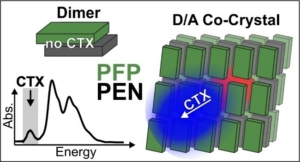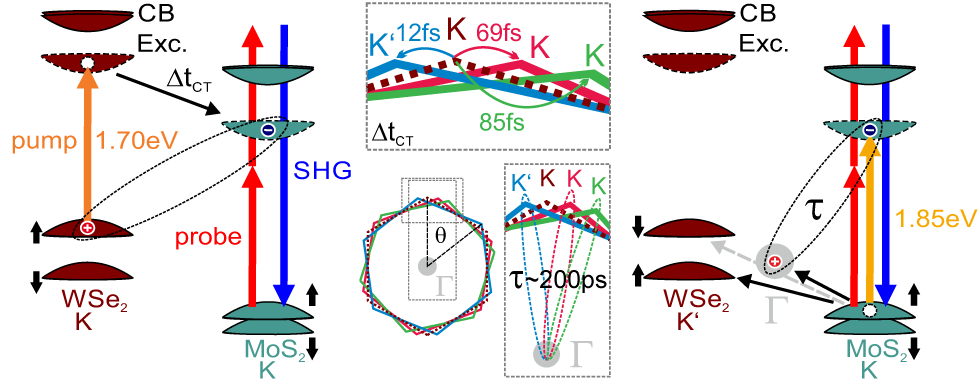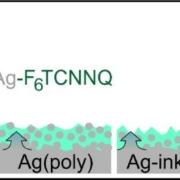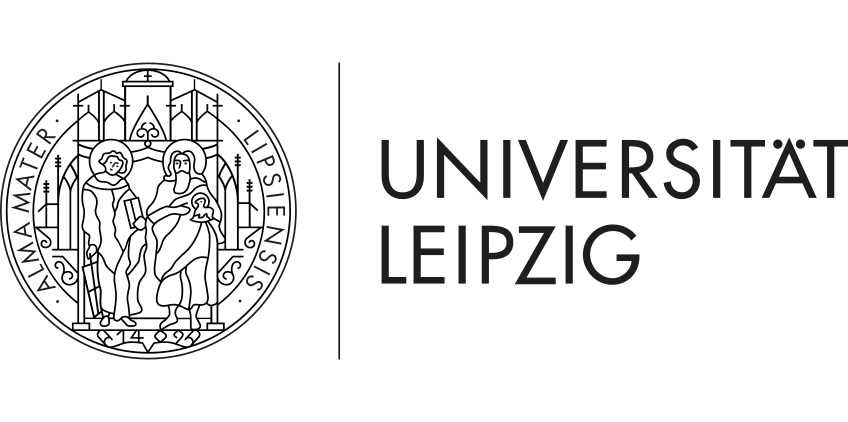Polarization Resolved Optical Excitation of Charge-Transfer Excitons in PEN:PFP Cocrystalline Films: Limits of Nonperiodic Modeling– Publication by A2 (Witte)
In their combined experimental and theoretical study published in The Journal of Physical Chemistry Letters, the groups of Caterina Cocchi and Gregor Witte investigated the nature of charge transfer excitons in crystalline PEN:PFP heterostructures.

Absorption and schematic representation of CTX that are only formed in crystalline solids and not in dimers (Image: D. Günder, Reprinted with permission from J. Phys. Chem. Lett. 2021, 12, 40, 9899–9905. Copyright 2021 American Chemical Society.)
Charge-transfer excitons (CTX) at organic donor/acceptor interfaces are considered important intermediates for charge separation in photovoltaic devices. While typically blends are used in real solar cells, their mostly amorphous arrangement prevents microscopic insights into the nature of such CTX states. In contrast, crystalline model systems allow to derive structure-property interrelations and also enable detailed theoretical modeling based on the known molecular arrangement.
In this study Prof. Witte and coworkers characterized the CTX of the prototypical molecular donor/acceptor system pentacene:perfluoropentacene (PEN:PFP). Using template controlled co-crystalline films of different orientation, allowed to precisely determine the polarization of the CTX state from angular-resolved UV/Vis absorption spectroscopy. Complementary, this co-crystalline system was analyzed theoretically in the group of Prof. Cocchi (Oldenburg) by first-principles many-body calculations and solving the Bethe-Salpeter equation, which confirms that the lowest-energy excitation is a true CTX state with a polarization along the molecular stacking direction. In addition, it was shown that analogous simulations performed on bimolecular clusters are unable to reproduce this state, which is ascribed to the lack of long-range interactions and wave-function periodicity in these calculations and represents an important finding for the description of molecular donor/acceptor systems.
Publication
D. Günder, A.M. Valencia, M. Guerrini, T. Breuer, C. Cocchi, G. Witte
Polarization Resolved Optical Excitation of Charge-Transfer Excitons in PEN:PFP Cocrystalline Films: Limits of Nonperiodic Modeling
J. Phys. Chem. Lett. 12 (2021) 9899 DOI:10.1021/acs.jpclett.1c02761
Contact
Prof. Dr. Gregor Witte
Philipps-Universität Marburg
SFB 1083 project A2
Tel.: 06421 28-21384
EMAIL











